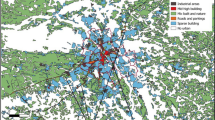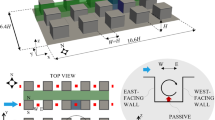Abstract
A simple energy balance model which simulates the thermal regime of urban and rural surfaces under calm, cloudless conditions at night is used to assess the relative importance of the commonly stated causes of urban heat islands. Results show that the effects of street canyon geometry on radiation and of thermal properties on heat storage release, are the primary and almost equal causes on most occasions. In very cold conditions, space heating of buildings can become a dominant cause but this depends on wall insulation. The effects of the urban ‘greenhouse’ and surface emissivity are relatively minor. The model confirms the importance of local control especially the relation between street geometry and the heat island and highlights the importance of rural thermal properties and their ability to produce seasonal variation in the heat island. A possible explanation for the small heat
Similar content being viewed by others
References
Arnfleld, A. J.: 1982, ‘An Approach to the Estimation of the Surface Radiative Properties and Radiation Budgets of Cities’, Physical Geog. 3, 97–122.
Bahl, H. D. and Padmanabhamurty, B.: 1979, ‘Heat Island Studies at Delhi’, Mausam 30, 119–122.
Barring, L., Mattsson, J. O., Lindqvist, S.: 1985, ‘Canyon Geometry, Street Temperatures and Urban Heat Island in Malmö, Sweden’, J. Climatol. 5, 433–444.
Bowling, S. A. and Benson, C. S.: 1978, ‘Study of the Subarctic Heat Island at Fairbanks, Alaska’, Environ. Monitor. Report No. EPA — 600/4–78–027, US EPA, Research Triangle Park, N.C., 150 pp.
Estournel, C., Vehil, R., Guedalia, D., Fontan, J. and Druilhet, A.: 1983, ‘Observations and Modelling of Downward Radiative Fluxes (Solar and Infra-Red) in Urban/Rural Areas’, J. Appl. Meteorol. 22, 134–142.
Goldreich, Y.: 1984, ‘Urban Topoclimatology’, Progress in Phys. Geog. 8, 336–364.
Hage, K. D.: 1972, ‘Nocturnal Temperatures in Edmonton, Alberta’, J. Appl. Meteorol. 11, 123–129.
Helbig, A.: 1987, ‘Beitrage zur Meteorologie der Stadtatmosphäre’, Abhandlungen des Meteorol. Dienstes der DDR, No. 137, Akademie-Verlag, Berlin, 80 pp.
Howard, L.: 1833, The Climate of London, Vols. I-III, London.
Ishikawa, N., H. Aburakawa and R. Naruse, 1978: ‘Urban-Rural Differences in the Daily Minimum Air Temperature During Nocturnal Radiative Cooling in Sapporo’, Low Temperature Research, Ser. A 36, 121–137.
Jauregui, E.: 1986a, ‘Tropical Urban Climates: Review and Assessment’, in Oke, T. R. (ed.), Urban Climatology and its Applications with Special Regard to Tropical Cities, WMO No. 652, World Meteorol. Organiz., Geneva, 26–45.
Jauregui, E.: 1986b, ‘The urban climate of Mexico City’, in Oke, T. R. (ed.), Urban Climatology and its Applications with Special Regard to Tropical Cities, WMO No. 652, World Meteorol. Organiz., Geneva, pp. 63–86.
Johnson, G. T., Oke, T. R., Lyons, T. J., Steyn, D. G., Watson, I. D. and Voogt, J. A.: 1991, ‘Simulation of Surface Urban Heat Islands, Part 1: Theory and Tests against Field Data’, Boundary-Layer Meteorol. 56, 275–294 (this volume).
Kobayashi, M.: 1982, ‘Influence of Urbanized Atmosphere on Long-Wave Radiation Field at Night’, Geog. Review Japan 55–6, 421–444.
Lee, D. O.: 1979, ‘Influence of Atmospheric Stability and the Urban Heat Island on Urban-Rural Wind Speed Differences’, Atmos. Environ. 13, 1175–1180.
Oguntoyinbo, J. S.: 1986, ‘Some Aspects of the Urban Climates of Tropical Africa’, in Oke, T.R. (ed.), Urban Climatology and its Applications with Special Regard to Tropical Cities, WMO No. 652, World Meteorol. Organiz., Geneva, pp. 110–135.
Oke, T. R.: 1973, ‘City Size and the Urban Heat Island’, Atmos. Environ. 7, 769–779.
Oke, T. R.: 1981, ‘Canyon Geometry and the Nocturnal Urban Heat Island: Comparison of Scale Model and Field Observations’, J. Climatol. 1, 237–254.
Oke, T. R.: 1982, ‘The Energetic Basis of the Urban Heat Island’, Quart. J. Royal Meteorol. Soc. 108, 1–24.
Oke, T. R.: 1986, ‘Urban Climatology and the Tropical City: an Introduction’, in Oke, T.R. (ed.), Urban Climatology and its Applications with Special Regard to Tropical Cities, WMO No. 652, World Meteorol. Organiz., Geneva, pp. 1–25.
Oke, T. R.: 1987, Boundary Layer Climates, Methuen, London.
Oke, T. R. and Fuggle, R. F.: 1972, ‘Comparison of Urban/Rural Counter and Net Radiation at Night’, Boundary-Layer Meteorol, 2, 290–308.
Oke, T. R. and Maxwell, G. B.: 1975, ‘Urban Heat Island Dynamics in Montreal and Vancouver’, Atmos. Environ. 9, 191–200.
Nakamura, Y. and Oke, T. R.: ‘Wind, Temperature and Stability Conditions in an East-West Oriented Urban Canyon’, Atmos. Environ. 22, 2691–2700.
Park, H.-S.: 1987, ‘Variations in the Urban Heat Island Intensity Affected by Geographical Environments’, Environ. Research Center Papers, No. 11, Univ. Tsukuba, Ibaraki.
Philip, N., Daniel, E., and Krishnamurthy, K.: 1973, ‘Seasonal Variation of Surface Temperature Distribution over Bombay’, Proc. Symp. Environ. Poll., New Delhi, pp. 308–317.
Rastorgueva, G. P.: 1979, ‘Temperaturnyj Rezhim Vozdukha Promyshlennykh Gorodov USSR’, Glavnaya Geofiz. Observ., Trudy No. 436, 111–117.
Roth, M., Oke, T. R. and Emery, W. J.: 1989, ‘Satellite-Derived Urban Heat Islands from Three Coastal Cities and the Utilization of Such Data in Urban Climatology’, Int. J. Remote Sensing 10, 1699–1720.
Sellers, W. D.: 1965, Physical Climatology, Univ. Chicago Press, Chicago.
Taesler, R.: 1980, ‘Studies of the Development and Thermal Structure of the Urban Boundary Layer in Uppsala, Part II, Data Analysis and Results’, Report No. 61, Meteorol. Instit., Univ. Uppsala, Uppsala.
Trewartha, G. T.: 1965, Japan, a Geography, Univ. Wisconsin Press, Madison, Wisconsin.
Tyson, P. D., Du Toit, W. J. F., and Fuggle, R. F.: 1972, ‘Temperature Structure above Cities: Review and Preliminary Findings from the Johannesburg Urban Heat Island Project’, Atmos. Environ. 6, 533–542.
Uno, I., Wakamatsu, S. and Ueda, H.: 1988, ‘Behaviour of the Nocturnal Urban Boundary Layer and Air Pollutants’, J. Japan. Soc. Air Pollut. 23, 103–114.
Voogt, J. A.: 1989, ‘Validation of an Urban Canyon Radiation Model for Nocturnal Long-Wave Radiative Fluxes and the Effect of Surface Geometry on Cooling in Urban Canyons’, M.Sc. Thesis, Dept. Geog., Univ. B.C., Vancouver, B.C.
Yamashita, S., Sekine, K., Shoda, M., Yamashita, K. and Kara, Y.: 1986, ‘On the Relationships between Heat Island and Sky View Factor in the Cities of Tama River Basin, Japan’, Atmos. Environ. 20, 681–686.
Yap, D.: 1975, ‘Seasonal Excess Urban Energy and the Nocturnal Heat Island — Toronto’, Arch. Meteorol. Geoph. Bioklima., Ser. B 23, 68–80.
Author information
Authors and Affiliations
Rights and permissions
About this article
Cite this article
Oke, T.R., Johnson, G.T., Steyn, D.G. et al. Simulation of surface urban heat islands under ‘ideal’ conditions at night part 2: Diagnosis of causation. Boundary-Layer Meteorol 56, 339–358 (1991). https://doi.org/10.1007/BF00119211
Accepted:
Issue Date:
DOI: https://doi.org/10.1007/BF00119211




